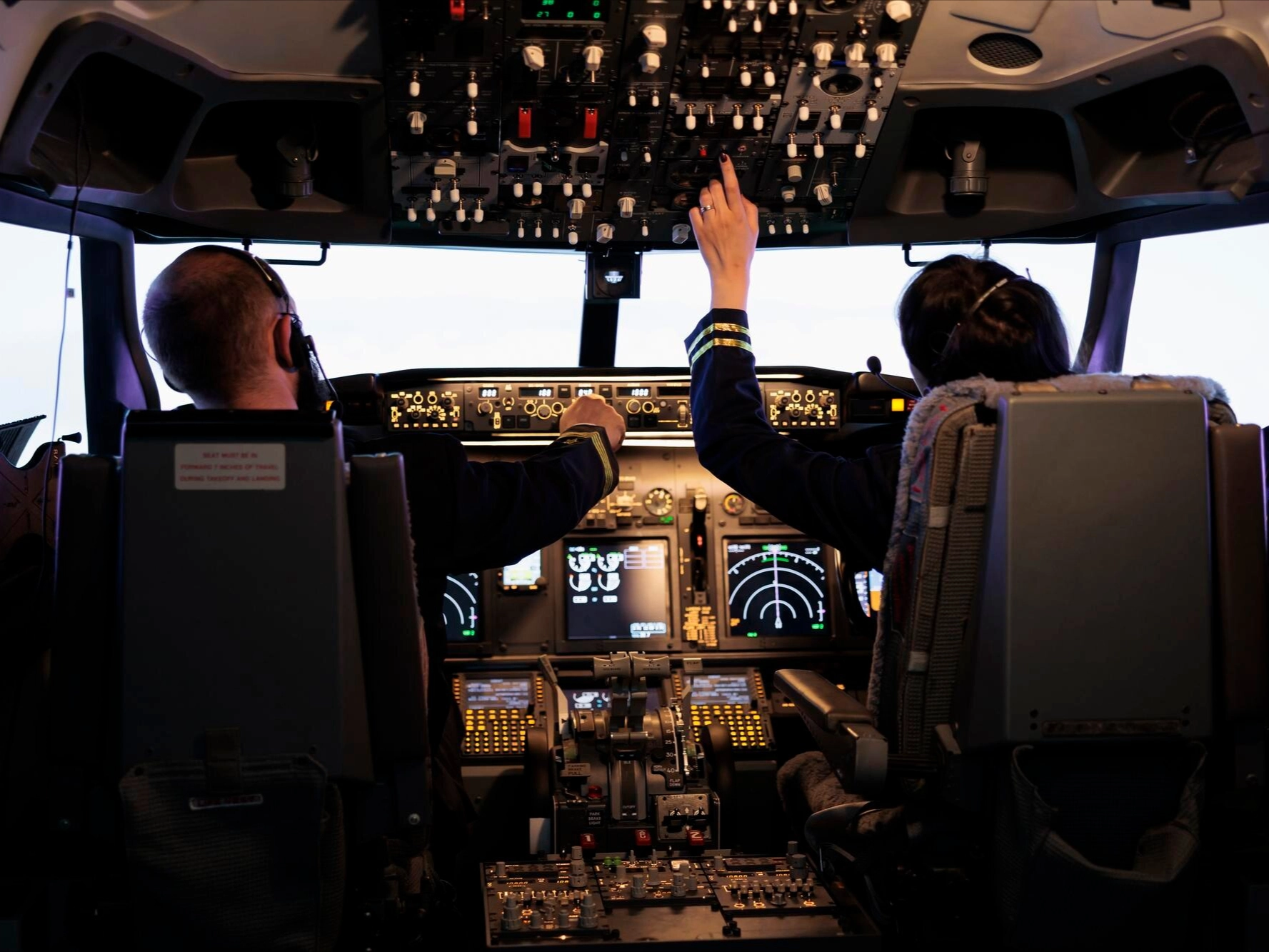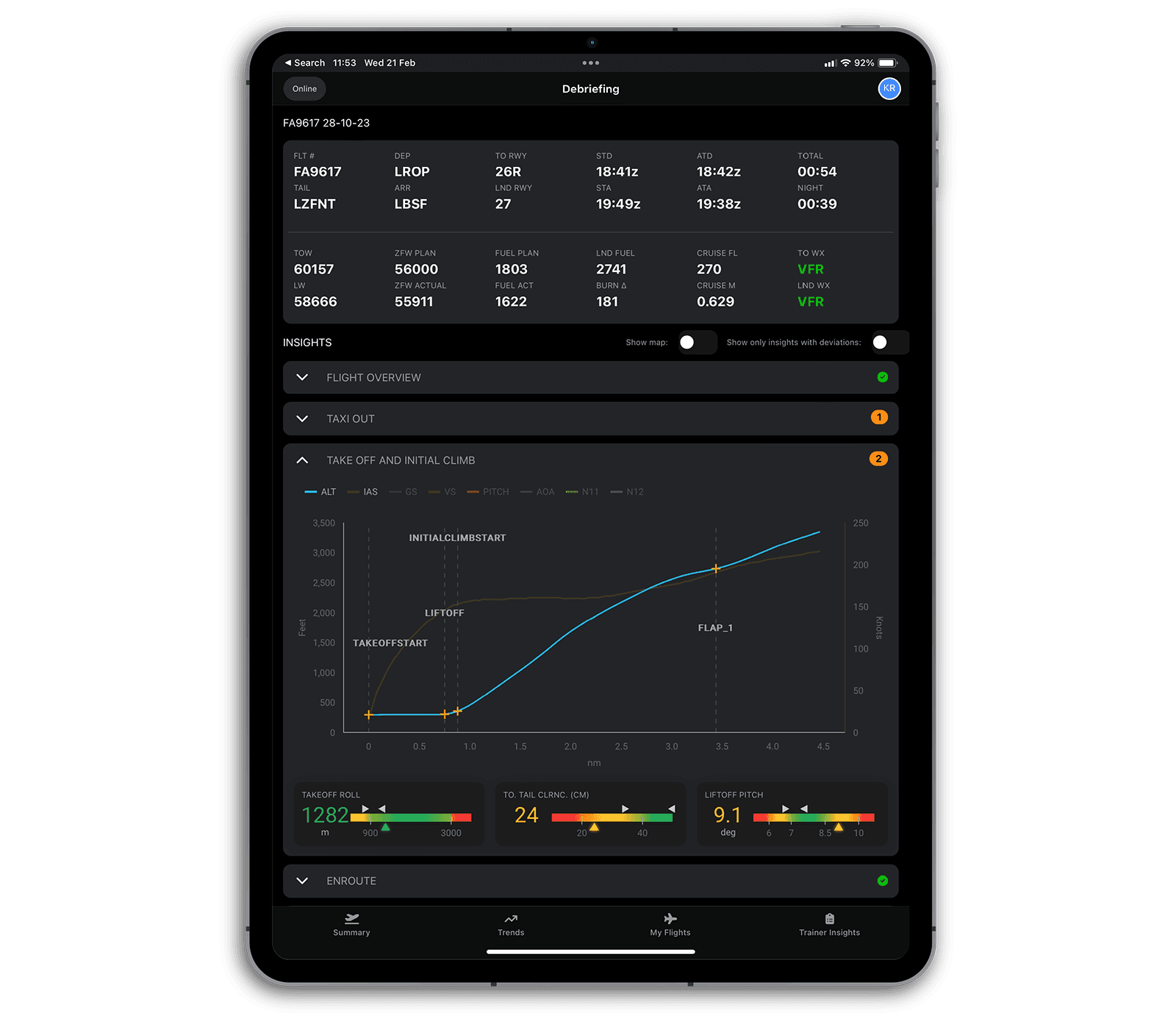FlightAdvise
The Benefits of Personalized Flight Data Monitoring Pilot Debriefings
- 2025-03-05
- 6 mins read

Flight Data Monitoring (FDM) is a crucial tool in aviation, primarily designed to enhance safety through meticulous analysis of flight operations. While FDM's role in safety is well acknowledged, the potential for these systems to empower pilots by directly sharing actionable insights remains largely untapped. This article explores the benefits of making these insights accessible to pilots, assesses the limitations of current FDM solutions, and discusses how modern technology can revolutionize the efficacy of these systems.
In the highly complex and dynamic environment of aviation, it is imperative that every stakeholder, especially pilots, has access to precise and timely information. Flight Data Monitoring (also know as Flight Operations Quality Assurance - FOQA in some areas of the world) is traditionally used to identify trends and monitor adherence to standard operating procedures. It can, however, extend far beyond its conventional boundaries. By integrating advanced FDM solutions into pilot de-briefing sessions, airlines can foster an environment where continuous improvement and safety are paramount.
Benefits of Sharing FDM Insights with Pilots?
Providing pilots with direct access to FDM insights offers numerous advantages that significantly enhance operational efficiency and safety. This transparency not only fosters a proactive safety culture but also empowers pilots to make informed decisions based on their personal flight data.
Empowered Decision-Making: Access to operational data enables pilots to identify trends and correct potentially unsafe practices before they lead to incidents. This immediate feedback loop supports quick adjustments and fosters a more dynamic approach to safety. For instance, if a pilot repeatedly experiences unstable approaches, the data can help pinpoint specific phases of flight that need attention, allowing for targeted corrective actions.
Increased Self-Awareness: Regular exposure to their flight data helps pilots recognize their flying habits and understand areas needing improvement or adjustment. This increased self-awareness is crucial for personal development and operational safety. Pilots can review their performance post-flight, understanding deviations from optimal flight paths or procedural errors and addressing them in subsequent flights.
Enhanced Safety Management: FDM provides a proactive platform for identifying potential safety threats early. Pilots can adjust their behavior based on real-time data, significantly reducing risk factors during flights. The ability to foresee and mitigate risks before they manifest ensures safer skies and smoother operations.
Targeted Training Opportunities: Data-driven insights allow for more personalized and effective training programs. By addressing specific areas of concern highlighted in FDM reports, training can be tailored to enhance a pilot’s skills where it is most needed. Customized training modules focusing on identified weaknesses ensure that pilots receive the best possible preparation for operational challenges.
Efficient Communication and Feedback Loops: Sharing insights facilitates open communication between flight crews and operations management, leading to improved understanding and collaboration on safety and performance standards. Enhanced dialogue based on concrete data fosters a culture of continuous improvement and mutual trust.
Current state of FDM solutions
Despite the evident benefits, many current FDM systems, such as Aerobytes, AirFASE and others, fall short in offering out-of-the-box solutions for sharing insights directly with pilots. These systems often lack the necessary contextual data to generate pilot-centric reports effectively, resulting in a significant dependency on manual processes.
Lack of Contextual Integration: The absence of contextual data means it is challenging to link specific flights to individual pilots, making it difficult to create personalized insights. Additionally, pilots require context—such as weather conditions and overall flight details—to effectively utilize the information and make informed decisions.
Dependence on Manual Processes: The absence of streamlined, automated processes for data handling leads to inefficient use of resources, with pilots or ground staff spending excessive time on report generation—time that could be better spent on core aviation tasks. This inefficiency hampers the timely dissemination of vital information, which is critical for maintaining high safety standards.
Data Privacy Risks: Manually building reports for pilots is time-consuming and risks data privacy breaches. Human errors in matching pilots to flights can expose sensitive information to the wrong person, compromising privacy and trust. Automated solutions securely and accurately link data to individuals, ensuring only relevant pilots receive their specific data. This keeps sensitive performance data between the system and the pilot, reducing unauthorized access or accidental leaks.
How Modern Technology Can Help
Advancements in technology offer promising solutions to the inefficiencies of current FDM systems by automating data sharing and making insights more accessible and secure. Leveraging the latest advancements in data analytics, artificial intelligence (AI), and mobile technology can transform the way flight data is utilized.
Automation and Real-Time Data Processing: Utilizing advanced analytics and artificial intelligence, FDM systems can automatically process and deliver flight data in real time, minimizing the need for manual intervention. Automated systems can generate comprehensive reports immediately after a flight, ensuring that pilots have instant access to their performance metrics.
Mobile Technology for Accessibility: Mobile applications provide pilots with secure, immediate access to their performance data. These apps can be equipped with features that allow pilots to view flight trends, receive safety alerts, and access personalized insights securely. The convenience of accessing data on-the-go enhances the pilot de-briefing process, making it more efficient and impactful.
Improved Security Measures: With sensitive data being shared on mobile platforms, modern solutions can enhance data security through encryption, controlled access, and secure authentication methods, ensuring that pilots’ data is protected against unauthorized access. Robust security protocols are essential to maintain the integrity and confidentiality of flight data.
 With technologies like Fliant's FlightAdvise pilot app, airlines can fully automate the process of sharing personalized FDM data reports.
With technologies like Fliant's FlightAdvise pilot app, airlines can fully automate the process of sharing personalized FDM data reports.
Conclusion
Incorporating modern technology into FDM systems represents a transformative step forward in utilizing flight data to enhance pilot performance and safety. Airlines looking to improve their operational practices must consider investing in advanced FDM solutions that automate data sharing and provide pilots with the tools necessary for success.
Fliant’s FlightAdvise pilot app exemplifies such a solution, integrating seamlessly with existing systems while offering advanced capabilities to meet the contemporary demands of aviation safety and pilot engagement. By choosing FlightAdvise, airlines ensure that their pilots are equipped with the best tools for enhancing safety and efficiency.
Advanced FDM solutions like FlightAdvise enable data-driven pilot de-briefings, transforming raw flight data into actionable insights. These insights facilitate continuous improvement, enabling pilots to refine their skills and adhere to best practices consistently. As the aviation industry evolves, embracing cutting-edge technologies in Flight Data Monitoring will be pivotal in safeguarding the future of air travel, ensuring that every flight is as safe and efficient as possible.